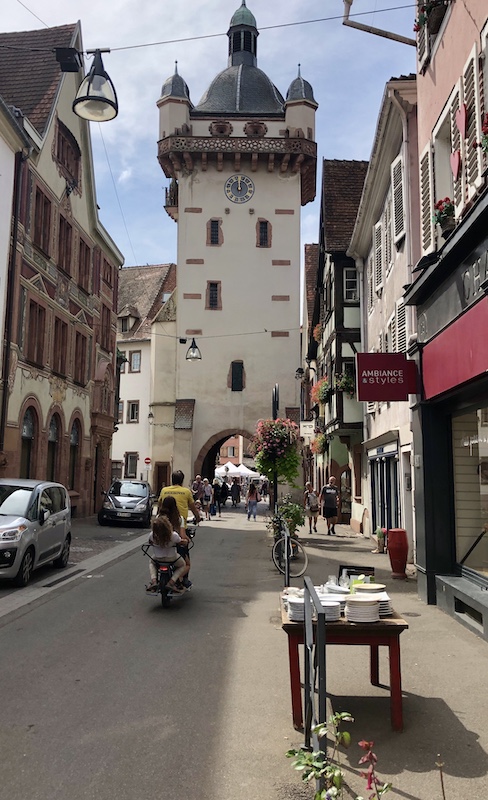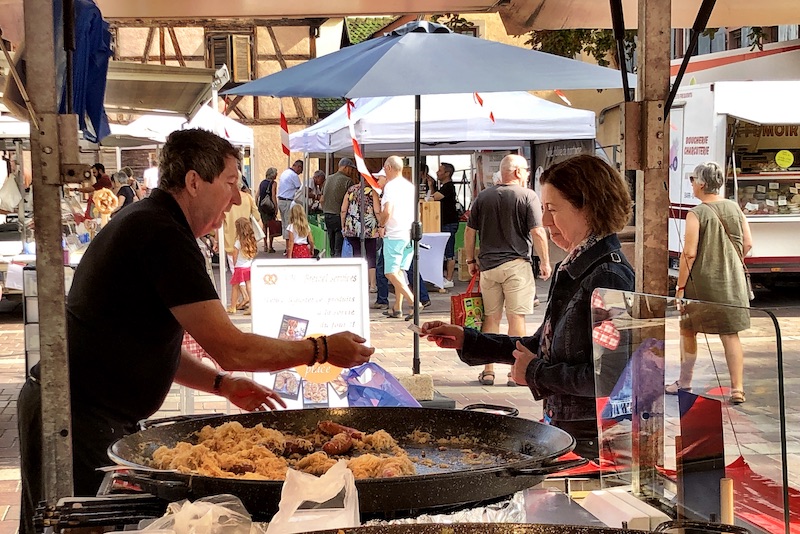The Alsace region of France is known for its Christmas markets. Photos of their twinkling lights, and gingerbread-style houses dusted with snow, are certainly enticing. But World War II history keeps me away. During the brutal battle for the Colmar Pocket, from November 1944 to February 1945, Allied forces faced off against the Germans in glacial temperatures. Knowing that, I can’t warm up to those outdoor markets in winter.
Instead, I prefer to visit at harvest time. Five years ago, I arrived in this part of eastern France in early September, expecting to spend one week and wound up staying for a month. My husband, Ken, and I have been back twice since then, most recently for ten days starting in late August.
The vendange, or grape harvest, which usually begins in early September and lasts about five weeks, had started at least two weeks earlier this year because of an unusually hot and dry summer. Tractors loaded with grapes slowed traffic along the Route des Vins, a two-lane road that weaves for 105 miles through this wine-producing region. Grape pickers, ranging from winemakers’ family members to migrant labor, crept up and down neatly planted rows, snipping the vines heavy with fruit. Most of the six varieties of white grapes raised here are household names in North America: Gewürztraminer, muscat, pinot blanc, pinot gris, Riesling and Sylvaner.
But the exuberance of the harvest goes beyond grapes. On a walk through the vineyards near our Airbnb in Sigolsheim, we stopped to say bonjour to a man picking peaches in what looked like a community garden. “Do you want some?” he asked in what turned out to be a rhetorical question. Before we could summon enough French to decline, he reached into his wicker basket and threw us two, over the fence.
In the late summer and early fall, the bounty of Alsace is on display at weekly outdoor markets. On our two previous trips to this region, we lived in Turckheim – a village with a small market, on Friday mornings, and bought all our produce there. As fall descended and the weather got chilly, I did a lot of cooking.
This year, unseasonably warm weather inspired us to visit additional markets but stay out of the kitchen. So we looked for items that could be easily assembled, or regional specialties sold as takeout foods. Each market had a different vibe, and we never went hungry. These are the ones we visited.
STRASBOURG, Place du Marché aux Poissons, Saturday, from 7:00 a.m. to 1:00 p.m.
As is my habit, I queued up on the longest line – the theory being that locals know what’s good. That proved true at La Ferme Saint Ulrich – a dairy counter selling many flavors of flan and yogurt. Customers were buying dozens of containers at a time, each holding about four ounces. Though I avoid lines back home, here it was a 15-minute, fidget-free wait, thanks to people-watching and foreign language immersion. When my turn came, I made six selections, including flan and coffee, coconut and lemon yogurt. (Turns out I grossly underestimated the speed with which we would consume them.)
Then on to a well-patronized charcuterie counter to admire the array of sausages. The old saw, that it’s best not to ask what goes into them, is probably good advice here. Alsatian cooking relies heavily on pork, and no part of the animal is wasted. But with flavors this complex and delicious, does it really matter?
Of the many variations on the theme, I have learned to recognize my favorites. What the German call Knackwurst are Strasbourg sausages here – a combination of beef and pork with a smoky flavor and hints of garlic and caraway seeds. The all-pork white links called cervelat are bland in the plain version, but also come seasoned with herbs. Cheese ones, made with local Munster or Swiss Emmenthal, ooze their cheesy filling as they cook.
This being the first market of the trip, I sought out mirabelles – the honey-flavored yellow plums, which are about the size of a cherry tomato. Associated with the nearby Lorraine region, they are also a much-prized late-summer fruit in Alsace. At the same farm stand, I bought fresh tomatoes to make into a meatless sauce on the day when we would inevitably want a break from sausage.

Most vendors in French markets won’t let you select your own tomatoes. But if you tell them that you plan to make a sauce, they will choose ones approaching the right degree of ripeness. Here, I serve the sauce over Grand’Mère brand pâtes d’Alsace – an egg-based pasta that is so delicate and delicious that I always leave the region with several bags of it. Though not available at outdoor markets, it’s widely sold in regional supermarkets and even in some souvenir shops.
SÉLESTAT, Rue du Président Poincaré, Tuesday, from 8:00 a.m. to noon
For snacking while we shopped, there were plain, sweet and savory soft pretzels – a food so iconic that they are part of the logo of Tourism-Alsace, the local tourist organization. A potato pancake offered as street food could be taken for Chanukah latkes, except that it was much less greasy than the ones I make back home. (Before World War II, Sélestat had a large Jewish population, and its last surviving synagogue, on Albert Ehm Square, overlooking the Tuesday market, can be visited by appointment.)
With many farms in the immediate vicinity, this is a town that’s proud of locally grown food. And in Sélestat I saw the first of many signs announcing La choucroute nouvelle est arrivée. It’s a reference to the fact that local farms have completed the process of turning their latest cabbage crop into sauerkraut. At markets, the finely julienned, pickled mainstay of Alsatian cuisine can be purchased directly from the producers. Elsewhere, butcher shops sell it, and encourage customers to use it inventively in recipes.
As for eating it uncooked – for example, atop a salad – vendors will tell you with some hesitation that it’s possible. Try it at your own risk: Raw sauerkraut can have a laxative effect.
A better choice is choucroute garnie – a scrumptious mélange of sauerkraut, Alsatian meats and boiled potatoes, cooked in wine and seasoned with garlic, bay leaves and juniper berries. Although it takes several hours to prepare, it is widely available as takeout.
My most recent helping came from a vendor at the Sélestat market who was serving it up from what looked like a giant paella pan. A sandwich board out front bragged that his choucroute came from Krautergersheim. Situated 20 miles northeast of Sélestat, it’s reputed to be the sauerkraut capital. And his send-up of this traditional dish was the best I have ever tasted. Though I ordered the smallest possible portion (€7.50, or about $7.50, for two meats, potatoes and sauerkraut), it was enough for two meals.
COLMAR, Place de l’Ancienne Douane, Thursday, from 6:00 a.m. to 7:00 p.m.; Saturday, from noon to 7:00 p.m.
Without question, this is a market for tourists. The prices are higher, and the hours are longer than at others we visited. Nor is there much in the way of local color.
It does, however, have historical and architectural interest. And given that the city of Colmar is on the must-see list for visitors to this region, it’s efficient to schedule sightseeing to coincide with a stop at the market.
The biweekly market is held outside a 19th-century brick and freestone building that at various times has been a customs house and a covered market. Designed by the architect Louis-Michel Boltz, it has doors that open onto a canal. In days gone by, this enabled farmers to easily unload their produce, transported to the market on flat-bottomed boats.
Today the landings have been converted into cafés attached to a restored covered market. They overlook the canal and are part of the section of the city referred to as “Little Venice.” In the southwest corner is a niche containing a statue called the Petit Vigneron (the little winemaker), designed by Frédéric-Auguste Bartholdi – the Colmar homeboy who created the Statue of Liberty.
My best find at the market was a fresh round of goat cheese from a farmer who was nearly sold out by the time we arrived at 11:00 a.m. When I asked for it demi-sec (half dry), he praised my choice and produced a photograph that showed goats grazing on fresh herbs. Another delicious purchase was a sugar-glazed brioche studded with chocolate chips, sold from a truck operated by Vincent Ley – a baker from the village of Wickerschwhir, which is about seven miles away.
Thus fortified, we strolled Colmar’s streets lined with half-timbered houses, hoping to reach the Musée Unterlinden just as others were going to lunch. This made it possible to linger with an audioguide at the 16th-century Isenheim Altarpiece, which is the museum’s star attraction, before stepping back into 21st-century Alsace.
GUEBWILLER, Place de l’Hôtel de Ville, Friday, from 8:00 a.m. to noon
Foodies who value freshness frequent the Friday market in this family-oriented village, stocking up for the weekend. More than at any other Alsatian market we visited, the produce displays looked like still life paintings. After our cumulative purchases of the week, we craved the market experience more than particular foods. Still, one thing we look for in this region is artisan breads. The German influence on Alsace – the region changed nationalities five times in the space of 150 years – has become baked in. So in addition to the usual baguettes and cereal breads, one finds offerings like beer bread, and a dark pain de campagne (country bread).
One from La Boulange du Gab, chock full of poppy, sesame and sunflower seeds, paired perfectly with the hearty Alsatian meats. While Ken chose the bread, I waited on the long queue at Les Saveurs du Ried – an Alsatian farm stand. The service there was genteel in the extreme: You’re assigned a server with a milk crate on wheels, who maneuvers it around the offerings without rushing you to make your selections. Mine also corrected my French when I asked for two more (deux de plus) ratte potatoes. Shaped like fingerlings, they are difficult to get in the U.S. and have a nutty flavor attributed to the local soil. I roasted them with rosemary, sold here in a bouquet that was bigger than my plant back home. Cucumber and black heirloom tomatoes for our salad rounded out the purchase.
Thus satiated, I’m not dreaming of a white Christmas in Alsace. But those who are can find dates and practical information here. With visions of mirabelle plums dancing in my head, I’ll be holding out for the next harvest.
Deborah L. Jacobs, a lawyer and journalist, is the author of Four Seasons in a Day: Travel, Transitions and Letting Go of the Place We Call Home and Estate Planning Smarts: A Practical, User-Friendly, Action-Oriented Guide. Follow her on Twitter at @djworking and join her on Facebook here. You can subscribe to future blog posts by using the sign-up box on her website’s homepage.
RELATED POSTS
Four Basque Markets That Are Worth the Journey
Four Périgord Markets That Are Worth the Journey
Three Normandy Markets That Are Worth the Journey
 In the late summer and early fall, the bounty of Alsace is on display at weekly outdoor markets, like this one in Guebwiller.
In the late summer and early fall, the bounty of Alsace is on display at weekly outdoor markets, like this one in Guebwiller.





